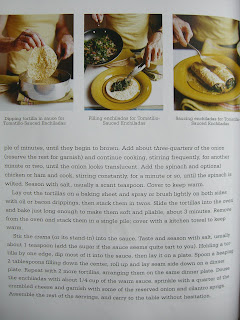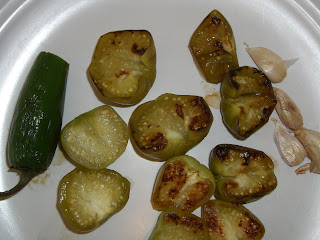 through my recent reading, I have learned that the American practice of always having beans and rice served as the sides on Mexican food plates is not traditional Mexican practice. Rather, rice and beans are often served as separate courses in their own right or one of the 2 will accompany a main dish on the same plate.
through my recent reading, I have learned that the American practice of always having beans and rice served as the sides on Mexican food plates is not traditional Mexican practice. Rather, rice and beans are often served as separate courses in their own right or one of the 2 will accompany a main dish on the same plate.Furthermore, in Mexican cookbooks, Rice is often lumped in a section called something like "sopa seca" (dry soup).
In any event, I lump the 2 together into a single entry here.
BEANS
On separate occasions now, I have taken a stab at simmered black beans and simmered frijoles rojos (kidney beans). In both cases, mostly followed the recipe displayed in the images. I took a pound of dried beans, added some chopped up shallot or onion, about 2 tablespoons of vegetable oil, and a bit less than 2 quarts of water and brought the mixture to a simmer in my medium-sized cast-iron Dutch oven on the stove. Then, I moved the Covered pot to a oven preheated at around 250°. After simmering for several hours, I remove the beans and add about 1.5 teaspoons of salt
Notes:
- as suggested in the more recent Bayless books, I did not soak the beans ahead of time
- on both occasions, I strained off the excess liquid after removing the beans from the oven; unfortunately, I did not realize that upon cooling, the beans would soak up much of the excess liquid and end up bringing the liquid level down a little too far
- the cooking time will really very from occasion to occasion: I let my black beans simmer for 4 or 5 hours in the oven and they were still nice and well structured, whereas, with the kidney beans, after 2.5 hours in the oven, they were beginning to decompose much more than I would like
- Despite adding epazote with the kidney beans, I was unable to detect the flavor

 RICE
RICEIn my attempts so far, I have loosely followed the procedure described in the images here. For health reasons, I have been using brown jasmine rice (1 cup). I have generally been adding at least 1 teaspoon of salt and have been adding 2 cups of water, bring to a boil and simmer in a very low heat for 45 or 50 minutes followed by a 5 or 10 minute cooling with the lid on still.
Notes
- on several occasions, I have added between 7 and 14 ounces of canned diced tomatoes. I have finally learned however, that this adds a large amount of water to the mixture; thus, the amount of water should be reduced in this version
- most recently, the Rice was still very soggy after the prescribed cooking time. I was able to largely salvage it by spreading it out flat in a baking pan and putting in a 250° oven for 10 or 20 minutes to dry out.
Update (3/20/2010):
I followed Bayless' recipe almost exactly this time, and the result was a disaster. In contrast to previous attempts, the rice was extremely dry this time. The one deviation was that I used drained, canned diced tomatoes instead of jarred salsa. Apparently typical salsas contain much more liquid than the diced tomatoes I used. Perhaps I will try his recipe one more time and actually use salsa...




































